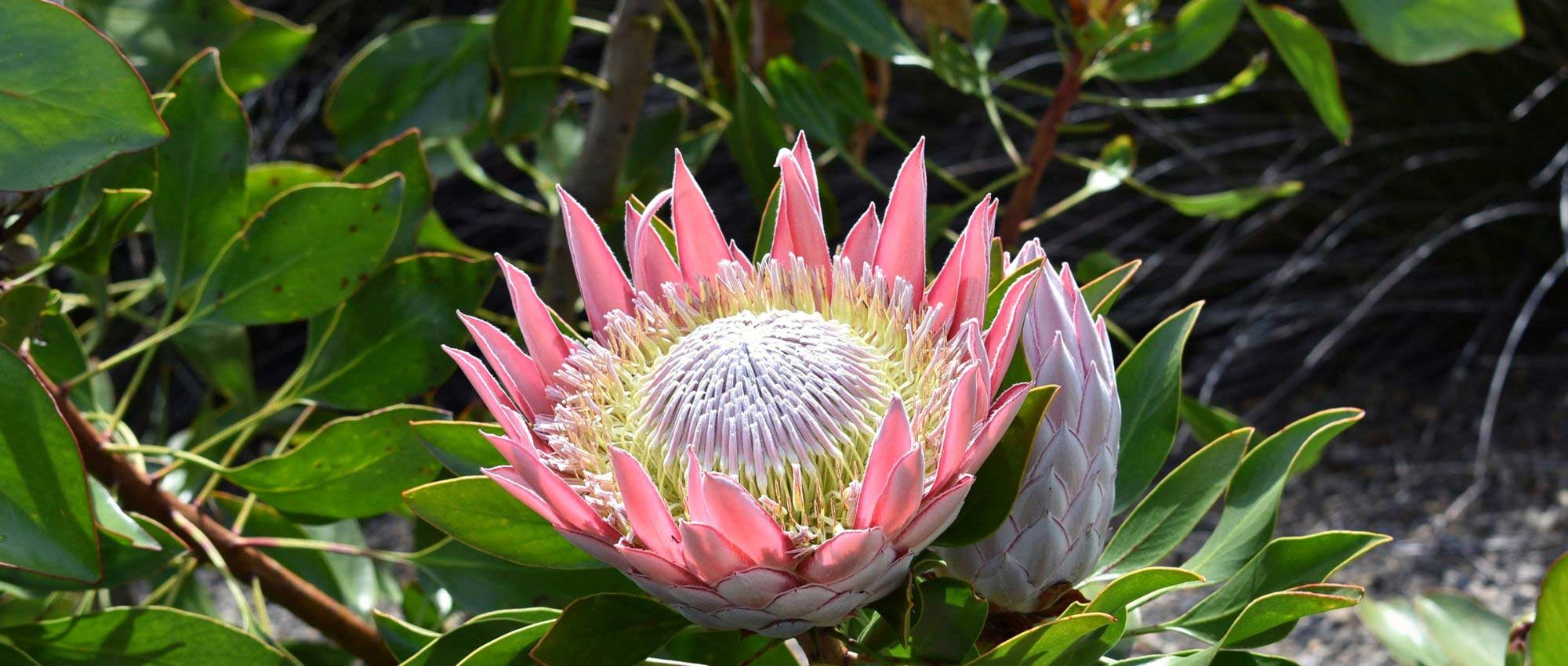
Proteas: planting, growing and care
Contents
Proteas in a nutshell
- Proteas produce spectacular flowering in warm, luminous hues
- Exotic, distinctive and uncommon plants in gardens
- They display attractive foliage, often blue-green, thick and evergreen
- They adapt well to container growing and are ideal in poor, rocky, free-draining soils
- These South African plants are quite frost-sensitive; protect them in winter!
A Word from Our Expert
Proteas are spectacular bushes with large inflorescences, edged with colourful bracts, which are generally available in shades of pink, red or orange. They form dense, ramified bushes, also decorative for their leaves. Leaves are thick and leathery, green, sometimes bluish. They are evergreen, remaining decorative even in winter. Emblem of South Africa, the royal Protea, Protea cynaroides, is one of the most prized in the garden. Proteas are plants that impress and fascinate. They are so different from other garden flowers! Their large inflorescences are ideal for attracting attention in a border and quickly become a focal point.
Protea is a rather specific plant, with particular requirements for substrate and to grow. They are not the easiest plants to grow, but with a few tips you can certainly succeed. Protea does not like lime, excess moisture or adding fertiliser. It needs a warm, sunny position and absolutely well-drained, rather acidic soil. To improve drainage, coarse sand can be added at planting time, possibly with a little gravel or pumice. Protea is ideal for integrating into a rockery, in combination with other plants that tolerate stony, fairly dry soils. You can also grow it in a pot, especially if you live in a cool climate, as this will allow you to overwinter it easily. In milder regions, planting in ground is preferable.
Botany
Botanical data
- Latin name Protea sp.
- Family Proteaceae
- Common name Protea
- Flowering between April and October
- Height generally less than 2.20 m
- Exposure full sun
- Soil type poor, very free-draining, rather acidic
- Hardiness not very hardy, down to -5 °C
Proteas are evergreen bushes mainly native to South Africa. Protea cynaroides is moreover national emblem of South Africa! There are about a hundred Protea species, and around 90 of them, including P. cynaroides, grow in Cape floristic region at southern tip of country. In nature Proteas occur in mountainous areas, in poor, rocky, acidic soils. They sometimes form true colonies, in association with other species, which helps protect them from wind. Proteas are particularly suited to poor, free-draining ground. They are also pyrophytic plants favoured by fire! In their natural environment fires are frequent: aerial parts of bushes burn, but this allows release of seeds and their germination, and some Protea species can resprout from stump (shoots develop after fire from underground stem).
Proteas gave their name to family Proteaceae, which includes more than 1,200 species. Notable genera include Banksia, Grevillea, Telopea, Leucadendron, Leucospermum, Embothrium, Isopogon… These plants are prized for very original flowerings in warm tones! Macadamia, which produces macadamia nuts, also belongs to this family. Proteaceae are plants of southern hemisphere, mostly native to South Africa and Australia.
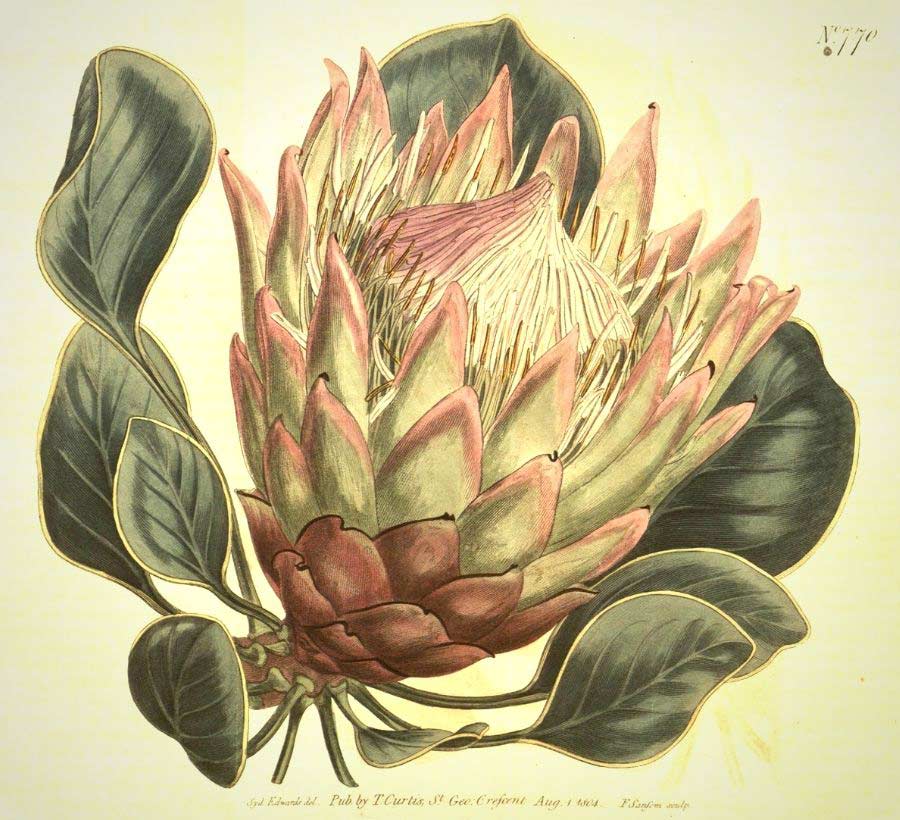
Protea cynaroides: Botanical illustration
Protea was named by Swedish naturalist Carl von Linné in reference to Greek god Proteus, who had the ability to change shape and metamorphose, because Proteas also display great diversity of forms!
Proteas are bushy bushes, not very tall, formed of thick, ramified stems. Generally they do not exceed 2.20 m in height, although some species are larger, such as Protea eximia (up to 5 m). Some species, conversely, have a spreading, prostrate habit. There are dwarf horticultural varieties, such as ‘Little Prince’ or ‘Mini King’, which do not exceed 1 m in height.
Depending on variety and climate, flowering can occur from spring to autumn, between March–April and October–November. Inflorescences are borne at stem tips, in terminal position. They are large, measuring between 8 and 30 cm in diameter, and cup-shaped. Flowers, when still in bud, resemble artichokes, but more elongated. Scientific name of Protea cynaroides indeed refers to artichoke (Cynara scolymus).
Protea inflorescences are truly impressive. Centre is flat or domed, and contains numerous flowers packed densely. Flowers consist of four sepals, four stamens (male organs bearing pollen) and a very long style (female organ receiving pollen). They are surrounded by a crown made up of numerous thick bracts, sometimes with velvety, even downy, edges. These bracts develop beautiful colours, often pink or red, sometimes yellow or orange. They look a lot like petals but are not. Protea neriifolia has pink bracts edged with black hairs, creating superb contrast!
Protea inflorescences are magnificent as cut flowers. They last long in a bouquet (between two and three weeks), and can also be used in dried arrangements.
In nature inflorescences are mainly pollinated by birds and beetles. Some species even orient their flowers towards ground to be pollinated by rodents!
After pollination flowers give way to a cone containing seeds. Plant needs fire to open fruits, release and germinate seeds.

Opening of a Protea cynaroides flower. Bracts progressively open to reveal numerous florets bearing stamens and pistil. (photos: sb616 / Winfried Bruenken / H. Zell)
Protea leaves are simple, entire, and measure between 5 and 15 cm long. They are fairly broad and elongated, with a well-marked central vein. Leaves can be green, but many species have bluish or silvery-reflecting leaves. It is quite common for lamina edge to be tinged red. Leaves are alternate, placed one after another on branches, and attached by a long petiole. They are coriaceous, stiff, and covered with a thick, waxy cuticle, which makes bush more resistant to drought (less water loss by evapotranspiration). In addition, leaves are relatively resistant to insect attacks.
Leaf shapes vary by species. Those of Protea neriifolia resemble oleander (Nerium oleander), which explains species name. In Protea nana they are needle-shaped and very similar to conifer leaves.
Protea leaves are evergreen, remaining on bush throughout year.
Proteas have fleshy, thick roots that penetrate deeply into soil. They allow plant to seek water at depth and to store water and minerals. They also enable plant to regenerate after fire. If aerial parts are destroyed by fire, Protea can nevertheless regrow from its roots!
Proteas have developed specialised roots, proteoid roots, which enable more intensive absorption of soil minerals. This makes these plants very well adapted to poor soils and explains why they do not tolerate presence of phosphorus in soil.

Foliage of Protea cynaroides (photos: Krzysztof Ziarnek, Kenraiz / Greenplanet.co.za) and that of Protea laurifolia, much finer (photo: Africa Wild Forum)
Read also
Plant and grow southern plantsDifferent varieties
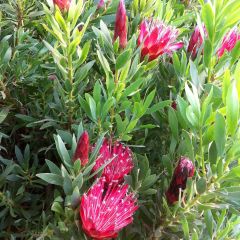
Protea Clarks Red
- Flowering time April to September
- Height at maturity 2,20 m
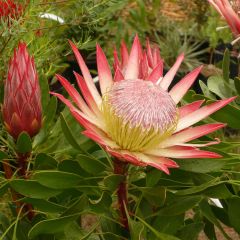
Protea Pink Crown
- Flowering time April to December
- Height at maturity 1 m
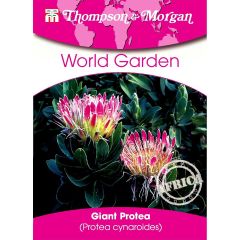
Protea cynaroides - Royal Protea
- Flowering time May to August
- Height at maturity 1 m
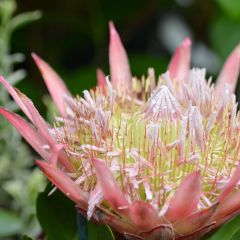
Protea cynaroides Little Prince
- Height at maturity 1 m
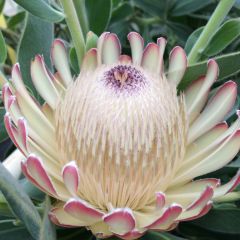
Protea Susara
- Flowering time April to June
- Height at maturity 1,75 m
Discover other Protea
View all →Available in 1 sizes
Available in 1 sizes
Available in 1 sizes
Available in 1 sizes
Available in 1 sizes
Available in 1 sizes
Available in 1 sizes
Available in 1 sizes
Available in 1 sizes
Available in 1 sizes
Planting
Where to plant?
Plant Protea preferably in full sun, as it needs a warm, bright spot. Ideally it should receive at least 6 hours of direct sun per day.
Protea dislikes standing moisture, which is why it is important to place it in a very free-draining substrate! Light, free-draining, loose soils suit it well. You can plant it in a rockery with other drought-tolerant plants. Growing Protea in a free-draining substrate allows its roots to get enough oxygen, preventing suffocation and rot.
Similarly, soil should be poor in organic matter. Avoid rich, humus-bearing substrates as well as heavy, clay soils. Protea has a root system truly adapted to poor soils! It has developed specialised roots called “proteoids”, which allow much greater uptake of mineral nutrients than conventional roots. Protea thrives in an acidic substrate and dislikes calcareous ground. The ideal pH is between 5.5 and 6.5. Finally, in the wild Protea grow on land where fires are frequent, and these bushes are even favoured by fire. To mimic their natural environment, we recommend adding a little ash or charcoal to the planting soil.
If you have a rockery corner that is free-draining and dry, it will be perfect for Protea. If your soil is heavy and clayey, prefer planting Protea in a pot, since this cultivation method also suits it very well. Likewise, in regions with a mild climate, for example around the Mediterranean or the Brittany coast, plant it in the ground, whereas in cooler regions subject to frost it is better to grow it in a pot and bring it under cover for winter.
Protea roots do not like to be disturbed. Take care, if you work in the bed, not to cultivate the soil too close to it. Likewise, once established, it is best to avoid transplanting.
Once well established, Protea can briefly withstand temperatures down to -10 °C.
When to plant?
Plant Protea in spring, from April–May, when risk of frosts has passed.
How to plant?
For planting in the ground:
- Dig a large planting hole, two to three times the size of the rootball
- You can add some heather soil and coarse sand, but absolutely no compost!
- Remove Protea from its pot and place it in the planting hole. Handle carefully as roots are fragile.
- Backfill substrate all around.
- Water generously with non-calcareous water.
For planting in a pot:
- Use a pot with drainage holes in the bottom for drainage. Ideally use a terracotta pot.
- Fill it with a mix of heather soil and coarse sand. You can also use perlite.
- Take the rootball and plant Protea in the pot, gently so as not to damage its roots.
- Backfill substrate all around, then water generously.
- Place the pot in a sunny position, for example on a terrace.
You can lay a pine bark mulch around Protea.
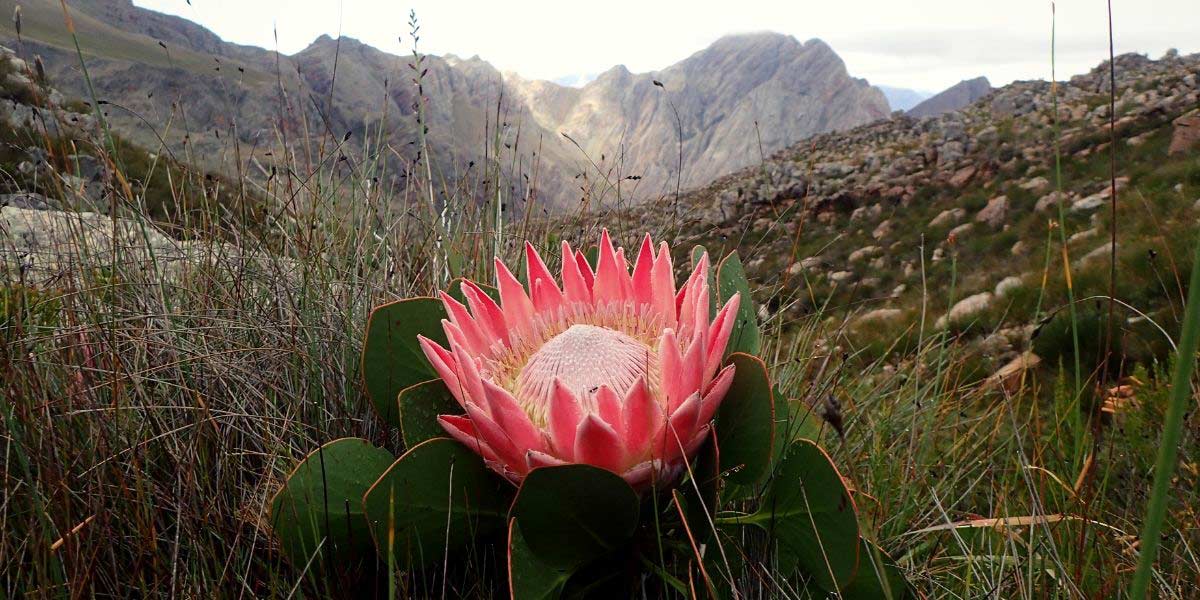
Protea cynaroides in its natural environment in South Africa
Care
Protea prefers substrate to remain slightly moist, but not waterlogged. If you grow it in a pot, waterings will need to be more frequent than if it is planted in ground. Water occasionally, allowing soil to become almost dry before watering again. Use rainwater where possible, as mains water may be too hard for Protea. Do not hesitate to add a thin layer of mulch (for example pine bark) around it to keep soil cooler for longer and limit weed growth. If you grow it in a pot, we strongly advise not to let water stand in the pot saucer, as excess moisture could cause root rot. Likewise, reduce watering in winter.
As Protea needs poor soil, avoid applying fertiliser or compost! It copes badly with phosphorus in particular.
As winter approaches, you can protect the plant by wrapping it in horticultural fleece, or, if you grow it in a pot, by bringing it into an unheated greenhouse or conservatory, away from frost. When young, Protea are more sensitive to cold (they become hardier over time); likewise, potted plants are more at risk from cold than those planted in ground. Installing a layer of mulch around the stump also helps protect it from cold.
Also remember to repot the plant from time to time in spring, as soon as you see it starting to become a little cramped in its pot.
Pruning improves flowering and helps keep bush more compact. You can prune after flowering, when flowers have faded. Cut back branches that have flowered fairly short, and take the opportunity to remove damaged or poorly positioned branches.
Multiplication: sowing, propagation by cuttings
Sowing Protea seeds
- Place seeds for 24 hours in water to which you have added one teaspoon of ashes or some charcoal.
- Prepare a pot with a very well-draining substrate (for example a mix of heather soil, coarse sand and perlite or vermiculite). We also recommend adding a little ashes.
- Sow seeds. They should be buried to a depth equal to their size.
- Place the sowing in a bright location with a temperature between 15 and 20 °C.
Seeds often take between 1 and 3 months to germinate, sometimes longer. Ensure substrate remains slightly moist until germination. Then repot young plants into individual pots, but keep them protected from frost during the first years. Expect 4 to 5 years for Protea to start flowering!
Propagation by cuttings
In summer, between July and September, take semi-woody cuttings measuring 10 to 20 cm long.
- Prepare a pot by filling it with a draining substrate (for example a mix of sand, potting compost and heather soil)
- Water so substrate is thoroughly moist.
- Prepare the cutting by removing leaves from the lower part of the stem. Keep only those on the upper third of the cutting.
- Plant the base of the cutting into the pot and firm the substrate all around to ensure good contact between stem and substrate.
- Cover with a bottle or a plastic bag to create a humidity-saturated atmosphere (propagation by cuttings under a plastic cloche).
- Place the pot in a warm, bright spot out of direct sunlight.
Companion planting
Use Proteas to create an exotic garden! Pair them with other southern plants originating from the Southern Hemisphere. Choose, for example, the Dasylirion, Phormium tenax, Callistemon, Dianella tasmanica… These are plants of mild climate and resistant to drought. You can create a bed planted with plants from South Africa! Enjoy, for example, the flowering of Kniphofia, Agapanthus, Crocosmia, Watsonia, Berkheya purpurea, Anisodontea… They are ideal if your garden is by the sea, and in any case will add an exotic, escapist touch!
For more information, discover our advice sheet: “Plant and grow southern plants”
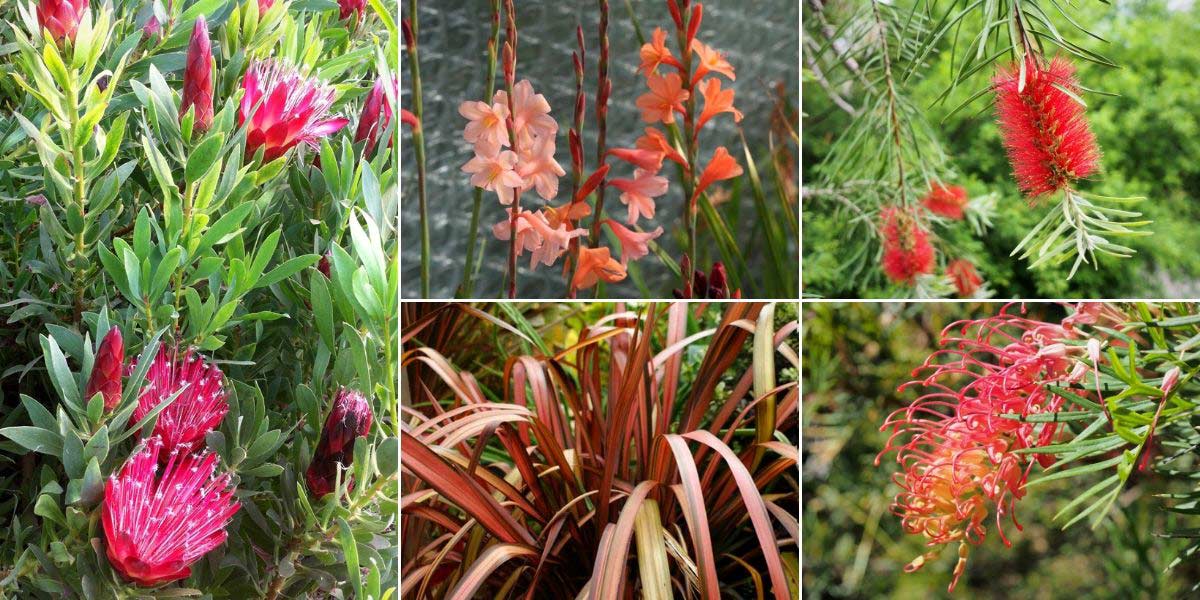
Pair Protea with other southern plants! Protea ‘Clarks Red’ (photo Stervinou), Watsonia ‘Peach Glow’, Callistemon rigidus, Phormium ‘Pink Panther’ and Grevillea ‘Joe Mason’
Proteas pair wonderfully with other Proteaceae, belonging to the same family: Leucadendron, Grevillea, Leucospermum, Banksia, Telopea, Embothrium… They have flowering in similar hues and thick foliage that blend very well together. These are fairly uncommon plants that surprise with their original flowering.
As they like well-drained, stony substrates and sunny exposure, you can integrate Proteas into a rockery, with other plants adapted to drought. Pair them, for example, with sedums, sempervivums, lavender, helianthemums, Echiums, euphorbias…
You can also place them in pots on your terrace to create an atmosphere evoking sun and exoticism. Place palms, arborescent ferns, bougainvillea, oleanders, santolina, Phormium… Favour plants with flamboyant flowering and exuberant foliage.
Useful resources
- Our Protea range
- Also discover Leucospermum, a plant quite similar to Protea!
- An article on our blog: ‘Botanical journey in South Africa’
Frequently asked questions
-
I have a Protea in my garden. Can I move it to replant it elsewhere?
Avoid transplanting Proteas whenever possible: they have a specialised root system and do not tolerate being moved. However, if you do need to move one, lift it by digging as widely as possible to avoid damaging roots, transplant it carefully, then water generously after planting.
-
Why isn't my Protea flowering?
If it is a young plant grown from sowing, it may still be too young. Wait 4 to 5 years after sowing to enjoy first flowers. If your Protea is an established young plant, check that its location suits it: it may be lacking light. An overly shaded spot may prevent or limit flowering. Finally, if the bush has been pruned too severely, or at the wrong time, this can prevent flowers from appearing.
- Subscribe!
- Contents
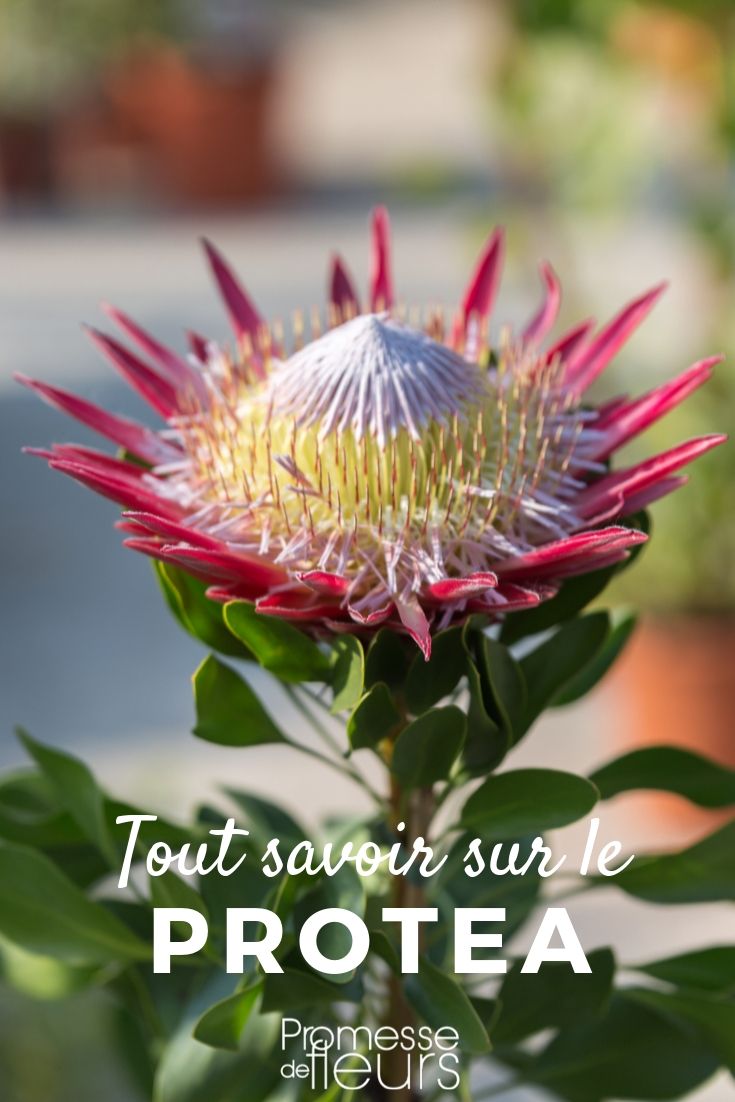


































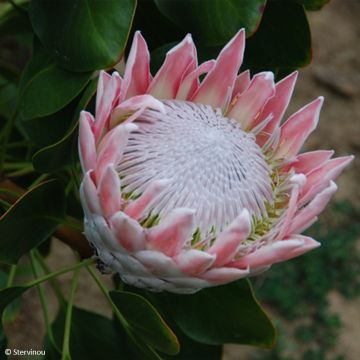
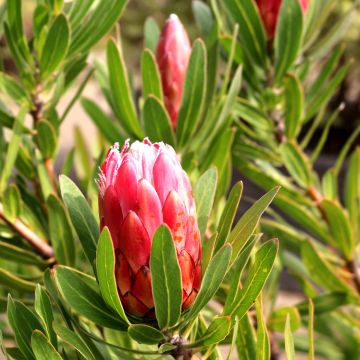
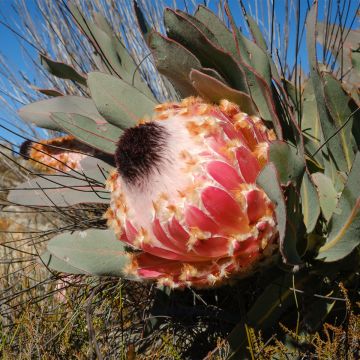
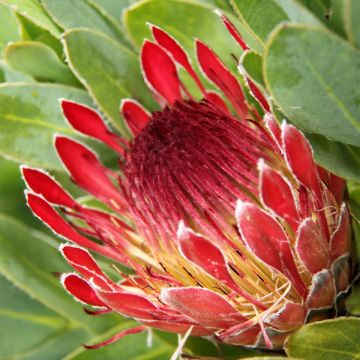

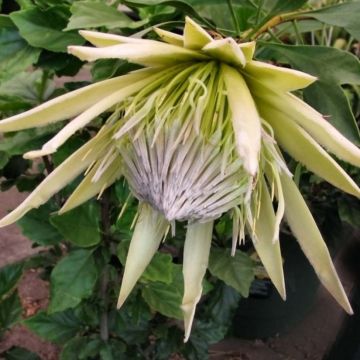

Comments